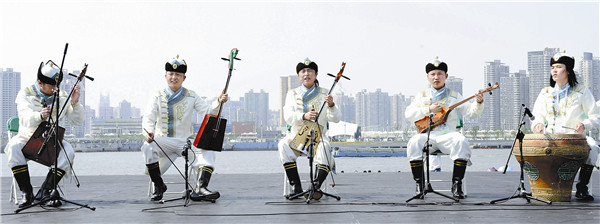Khoomei's origins are uncertain. But it is generally believed to have derived from herders' imitations of animal sounds and to have later been incorporated by lamas into religious rituals.
It's the first day of a new semester at Od Suren Khoomei School, which is located in a roughly 60-square-meter office. The first few minutes resemble a yoga class, as more than 20 students enter the room and lie on the ground. On their backs, they raise their heads and stretch their legs while chanting.
"It's physical exercise," Durenjana says.
"But it's essential to control your breathing when singing Khoomei."
Durenjana comes from Xilinhot, capital of Xilin Gol League in the north of Inner Mongolia, about 600 km from Hohhot.
Durenjana and the three men rent an office's attic for 200 yuan ($33) each a month.
They eat, sleep and - literally - breathe Khoomei during the three-week course. All four run 3 km a night to build up their lung capacity.
Their 65-year-old teacher Od Suren is from Mongolia. He's the deputy director of Mongolia's National Khoomei Association and among the world's leading educators of the art. He introduced the throat-singing tradition to his country's university syllabus.
Od Suren first visited China in 1993 and enrolled six students to learn this nearly vanished skill. He has taught more than 1,000 Chinese students since. Many of the autonomous region's top Khoomei singers are his former students.
Khoomei was placed on the UNESCO Intangible Cultural Heritage List in 2009, representing China rather than Od Suren's homeland.
 |
|
Khoomei singers from the Inner Mongolia autonomous region gave a performance at the 2010 Shanghai World Expo. Yang Shirao / Xinhua
|
This has earned the ire of some of Od Suren's compatriots. But he continues to spread this traditional music globally and is rarely drawn on the cross-border barbs.
"We've attracted so many young people," he says.
"That's what's important to me."
Od Suren's only ethnic Han student currently studying is 31-year-old traditional Chinese medicine doctor Zhang Li, who has come from Beijing.
Zhang says the fact he doesn't understand Mongolian doesn't negate his comprehension of the melodies' emotions.
"I'm lucky to have a nice teacher who tolerates my poor performance," he says.
Zhang became fascinated by Khoomei when he met a singer in a remote Tuvan village in the Xinjiang Uygur autonomous region in 2003. He has since sporadically learned it from musician friends.
"I don't know of any such regimented Khoomei class in Beijing," Zhang says.
Zhang has taken leave from his job to attend full time. "Khoomei was sung by ancient Shamanism priests, who were also doctors. So I believe it has medical value."
Many rock bands incorporate Khoomei in their acts. But Od Suren believes the tradition should remain in a pure form.
"Modern music can only borrow some elements from Khoomei," he says.
"Authentic Khoomei never changes. It comes from nature."
That's why he often gives lessons on the mountains that crest Hohhot's northern fringe. "Students get closer to nature there," he says.
Temur, a Hohhot-native Khoomei vocalist who launched the school in 2011, says there are two other teachers from Mongolia maintaining regular curriculums based on students' levels. But Od Suren provides all students with a solid foundation.
"Basic skills won't take too long for someone who wants to become professional," Temur says.
We recommend:
